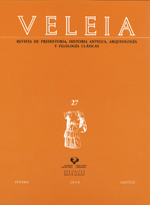"Segontia Lanca" ("Hispania Citerior"). Propuesta para la identificación de la ciudad celtíbera y romana
##plugins.themes.bootstrap3.article.main##
##plugins.themes.bootstrap3.article.sidebar##
Abstract
The development of the Celtiberian and Roman community of Segontia Lanca (Hispania Citerior), in the Upper Duero, between 2nd century B.C. and 2nd century A.D. is assessed. We propose that the following development took place: The pre-Roman city of Segontia Lanca developed as a power centre from the Castro oppidum (Valdanzo, Soria). After the Roman conquest, between 124 and 98 B.C., it was decided to transfer this city to its new location at Las Quintanas-La Cuesta del Moro (Langa de Duero, Soria). The caput urbis of the Late Republican and Augustus-Tiberian Segontia Lanca was founded here. The secotiaz lacaz mint was located in this community. For reasons which still need to be investigated, Segontia Lanca became a multiurban community at the start of the 1st century A. D., comprising a relocated caput urbis and two smaller urban nuclei that were also within its territory. The paper also considers whether this civitas was granted the status of municipium in the 1st century A. D.
Downloads
##plugins.themes.bootstrap3.article.details##
Unless otherwise noted, the contents of the electronic edition of the OJS platform are licensed for use and distribution under a Creative Commons Attribution-NonCommercial-NoDerivatives 4.0 International (CC-BY-NC-ND) license.
The journal does not charge any financial compensation to authors for publishing in it and provides full access to the archives without any kind of embargo from the day of electronic publication. This respects the national open access policy.
All originals published in the journal Veleia, whether in print or digital format, are the property of the University of the Basque Country (UPV/EHU). © UPV/EHU
Authors of articles (whether research articles, news articles, news items or reviews) will be able to access their own work on the Journal's website. Authors will be able to put them in their personal repositories and will also have the possibility of pre-print dissemination of articles accepted for publication.

